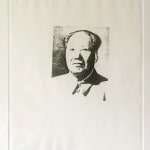-
Artworks

Andy Warhol
Mao , 1978Screen print on Curtis Rag Paper22 3/8 x 17 1/2 in
56.8 x 44.5 cmSeries: MaoCopyright The ArtistFurther images
Andy Warhol's Mao series, created in 1972, stands as a notable departure from his earlier subjects and marks a significant shift towards exploring political figures and power in his art....Andy Warhol's Mao series, created in 1972, stands as a notable departure from his earlier subjects and marks a significant shift towards exploring political figures and power in his art.
The Mao series comprises a collection of silkscreen prints that depict the iconic image of Mao Zedong, the Chairman of the Communist Party of China. Warhol based these prints on a famous photograph of Mao, portraying the leader in a frontal and almost propagandistic style, much like the images distributed during the Cultural Revolution in China.
Warhol's depiction of Mao captures the enigmatic and authoritative aura surrounding the political figure, yet the repetition of Mao's image in the series adds a layer of ambiguity and contemplation. By repeating the same image in various colors and compositions, Warhol challenges the singular authority of the subject and raises questions about the idolization of political figures in mass media.
The series reflects Warhol's interest in the intersection of politics and popular culture, as well as his fascination with celebrity and fame. Mao, an influential political figure, is reimagined by Warhol within the context of mass production and consumerist aesthetics, blurring the lines between political power and celebrity status.
Warhol's Mao series sparked discussions about the commodification of political figures and the cult of personality surrounding influential leaders. Through these prints, he provokes contemplation about the manipulation of images in politics and the pervasive influence of media in shaping public perception.
Despite its departure from Warhol's more mainstream subjects, the Mao series remains a significant commentary on the intersections of politics, power, and media in contemporary society. It stands as a testament to Warhol's ability to provoke thought and dialogue through his art, challenging viewers to reconsider the nature of authority and representation in the realm of popular culture and politics.
1of 13

